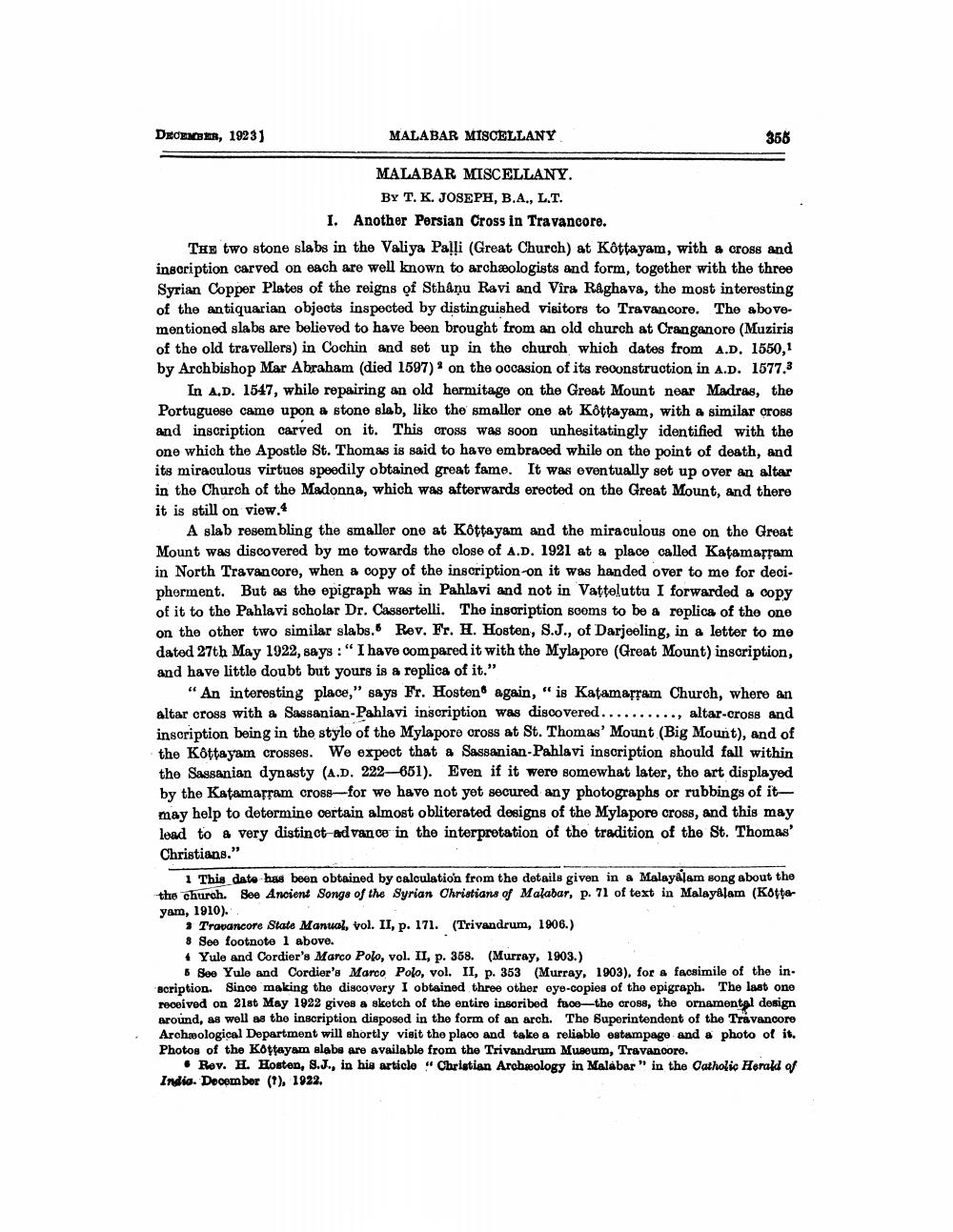________________
DECEMBER, 19231
MALABAR MISCELLANY
356
MALABAR MISCELLANY.
BY T. K. JOSEPH, B.A., L.T.
1. Another Persian Cross in Travancore. The two stone slabs in the Valiya Palli (Great Church) at Kottayam, with a cross and inscription carved on each are well known to archæologists and form, together with the three Syrian Copper Plates of the reigns of Sthåņu Ravi and Vira Raghava, the most interesting of the antiquarian objects inspocted by distinguished visitors to Travancore. The abovementioned slabs are believed to have been brought from an old church at Cranganore (Muziris of the old travellers) in Cochin and set up in the church which dates from A.D. 1550,1 by Archbishop Mar Abraham (died 1597) on the occasion of its reconstruction in A.D. 1577.3
In A.D. 1547, while repairing an old hermitage on the Great Mount near Madras, the Portuguese came upon a stone slab, like the smaller one at Kottayam, with a similar cross and inscription carved on it. This cross was soon unhesitatingly identified with the one which the Apostle St. Thomas is said to have embraced while on the point of death, and its miraculous virtues speedily obtained great fame. It was eventually set up over an altar in the Church of the Madonna, which was afterwards erected on the Great Mount, and there it is still on view.4
A slab rosem bling the smaller one at Kottayam and the miraculous one on the Great Mount was discovered by me towards the close of A.D. 1921 at a place called Katamarram in North Travancore, when a copy of the inscription-on it was handed over to me for deci. pherment. But as the epigraph was in Pahlavi and not in Vatteluttu I forwarded a copy of it to the Pahlavi scholar Dr. Cassertelli. The inscription sooms to be a replica of the one on the other two similar slabs. Rev. Fr. H. Hosten, S.J., of Darjeeling, in a letter to me dated 27th May 1922, says "I have compared it with the Mylapore (Great Mount) inscription, and have little doubt but yours is a replica of it."
"An interesting place," says Fr. Hosten again," is Katamarşam Church, where an altar cross with a Sassanian-Pahlavi inscription was discovered.........., altar-cross and inscription being in the style of the Mylapore cross at St. Thomas' Mount (Big Mount), and of the Kottayam crosses. We expect that a Sassanian-Pahlavi inscription should fall within the Sassanian dynasty (A.D. 222-651). Even if it were somewhat later, the art displayed by the Katamarram cross-for we have not yet secured any photographs or rubbings of itmay help to determine certain almost obliterated designs of the Mylapore cross, and this may lead to a very distinct advance in the interpretation of the tradition of the St. Thomas' Christians."
1 This date has been obtained by calculation from the details given in a Malayalam song about the the church. See Ancient Songs of the Syrian Christians of Malabar, p. 71 of text in Malayalam (Kotteyam, 1910).
Travancore State Manual, vol. II, p. 171. (Trivandrum, 1906.) 8 See footnote 1 above. * Yule and Cordier's Marco Polo, vol. II, p. 368. (Murray, 1903.)
6 See Yule and Cordier's Marco Polo, vol. II, p. 353 (Murray, 1903), for & facsimile of the in. scription. Since making the discovery I obtained three other eye-copies of the epigraph. The last one received on 21st May 1922 gives a sketch of the entire inscribed face—the cross, the ornamental design around, as well as the inscription disposed in the form of an arch. The Superintendent of the Travancore Archæological Department will shortly visit the place and take a reliable estampage and a photo of it. Photos of the Kottayam slabs are available from the Trivandrum Museum, Travancore.
Rov. H. Hoston, S.J., in his articlo Christian Archaeology in Malabar" in the Catholic Herald of India. December (1), 1922.




